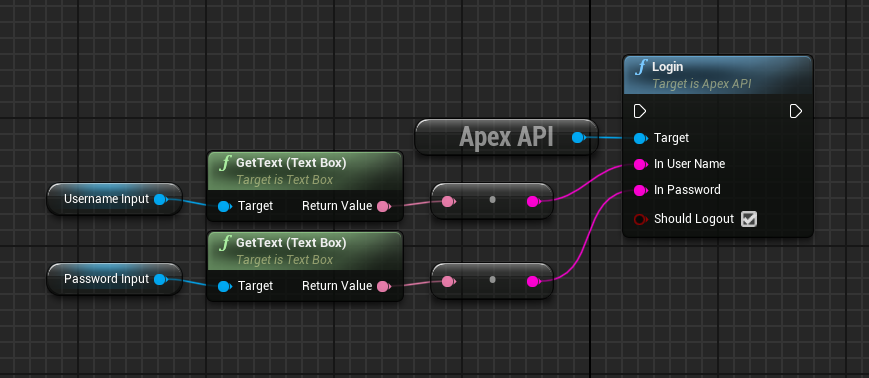|
|
Documentation for the UE5 C++ Plugin
|
|
|
Documentation for the UE5 C++ Plugin
|
Authentication with PixoVR Platform is as simple as calling the Login function. If you read the PixoVR Platform SDK documentation you can get a better understanding of what is happening under the hood, but the SDK automates nearly everything and makes authentication a breeze.
To authenticate, you must pass a username and password to UPixoAuth::Login(). You can also bundle an Assisted Login code, generated on the PixoVR Platform, as the username and any length string into the password and pass it to UPixoAuth::Login().
Features of this function are that it:
TRUE.FALSE if the password or login are of zero length.More and more users are adopting the Hub App. Alongside the many features of the Hub App, one feature, Authenticated Launches, are something you'll want to integrate with your application. Authenticated Launch takes a user who is already logged and passes their user token into another application.
You can check if your application has been passed a user token by calling UPixoAuth::HasLaunchAuthToken(), which will return true if there is a token waiting for you to use.
Now that you know there is a token, you'll want to call UPixoAuth::LoginWithAuthToken(). This function takes the token and calls a login flow. After this function is called, you can follow the login event flow to know when the users token has been verified and the users information is available to your application.
When your application exits, it's important to return the user to the Hub App, or in the case of Saudi, the Training Academy.
You can do this with a call to UPixoAuth::AuthenticatedLaunched, which takes in 1 parameter.
InReturnTarget:FString - This should be blank.The UE5 PixoVR Platform SDK provides a way to receive the data from the API calls. The approach in the UE5 PixoVR Platform SDK is done through both a generalized Success and Fail Delegate.
In Blueprint you will bind a function or event to the following Delegates.
UPixoAuth::OnAuthorizationCompleted(const FPLoginData&, AuthorizedUser, const class UVaRestRequestJSON*, Request): Called when the users information is valid and has access to the module.
AuthorizedUser contains information about the user who has logged in, all of the information that is also stored in UPixoAuth::CurrentActiveLogin.Request will contain the raw Json values for the successful response.UPixoAuth::OnAuthorizationFailed(FPRequestFailed, FailedRequestResponse, const class UVaRestRequestJSON*, Request) : Called when the users information is invalid, does not have access to the module or the server is not able to be reached.
FailedRequestResponse will contain the error message and HTTP response code.Request will contain the raw Json values for the failed response.In C++ you will bind a function to delegates with the same data as the Blueprint.
UPixoAuth::OnStaticAuthorizationCompleted(const FPLoginData&, const class UVaRestRequestJSON*): Called when the users information is valid and has access to the module.
UPixoAuth::OnStaticAuthorizationFailed(FPRequestFailed, const class UVaRestRequestJSON*): Called when the users information is invalid, does not have access to the module or the server is not able to be reached.
In the Example Code section, you'll see both Blueprint and C++ examples on how to bind to the event delegates.
To authenticate, you need to reach the UPixoAuth Game Instance Subsystem. We've provided examples of how to reach it.
Using Blueprint:

Using C++:
You will also need to add the ApexSDK as a dependency module name in the project's Build.cs file in order to make this call in C++.
If you're handling a response in C++, you will also want to add "VaRest" to the project's dependency module list.
Below is an example of how to call the authentication function UPixoAuth::Login().
Using C++:
Using Blueprint:

Successful Request Response

Failed Request Response

We've decided to provide some notes on questions we've been asked about authentication.
Q. Is the users information encrypted?
A. Yes, but not by anything internal to the UE5 PixoVR Platform SDK or API calls. Instead, we use TLS over HTTPS.
Q. Does the Login call do anything besides log-in the user?
A. Yes, Login goes beyond and checks the user against the module to see if they have access to module. During this, we also pass back some module and user specific information which will be seen a successful login response.